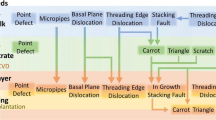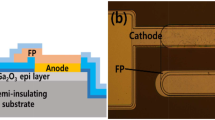Abstract
Future high-energy physics experiments require highly segmented silicon sensors of increased geometrical efficiency with the ability to withstand extremely high radiation damage. The performance of planar n-on-p sensors with active edges is simulated at high radiation fluences up to 1 × 1016 neq/cm2, using a three-level trap model for p-type silicon material. Taking advantage of the secondary ion mass spectrometry (SIMS) technique, an accurate representation of the structure was obtained in terms of doping profile. The breakdown voltage, leakage current, hole density and electric field distributions as well as the charge collection efficiency (CCE) are studied as a function of radiation fluence.









Similar content being viewed by others
Notes
Groupe d’Etude de la Matière Condensée. Université Versailles-Saint Quentin en Yvelines.
References
S. Jezequel, Nucl. Phys. B Proc. Suppl. 245, 145 (2013)
E. Currás, M. Fernández, C. Gallrapp, L. Gray, M. Mannelli, P. Meridiani, M. Moll, S. Nourbakhsh, C. Scharf, P. Silva, G. Steinbrueck, T.T. de Fatis, I. Vila, Nucl. Instrum. Methods Phys. Res. Sect. Accel. Spectrometers Detect. Assoc. Equip. 845, 60 (2017)
B. Schmidt, J. Phys: Conf. Ser. 706, 022002 (2016)
G. Bolla, D. Bortoletto, G.P. Grim, R.L. Lander, Z. Li, S. Willard, Nucl. Instrum. Methods Phys. Res. Sect. Accel. Spectrometers Detect. Assoc. Equip. 423, 290 (1999)
O. Koybasi, G. Bolla, D. Bortoletto, I.E.E.E. Trans, Nucl. Sci. 57, 2978 (2010)
M. Mekheldi, S. Oussalah, A. Lounis, N. Brihi, Results in Physics 6, 80 (2016)
D. Djamai, E. L. Gkougkousis, M. Chahdi, A. Lounis, and S. Oussalah, in 2018 Int. Semicond. Conf. CAS (Sinaia, Romania, 2018), pp. 227–230. https://ieeexplore.ieee.org/document/8539752
T. Peltola, X. Wu, J. Kalliopuska, C. Granja, J. Jakubek, M. Jakubek, J. Härkönen, A. Gädda, Nucl. Instrum. Methods Phys. Res. Sect. Accel. Spectrometers Detect. Assoc. Equip. 813, 139 (2016)
M. Meschini, G.F. Dalla Betta, M. Boscardin, G. Calderini, G. Darbo, G. Giacomini, A. Messineo, S. Ronchin, Nucl. Instrum. Methods Phys. Res. Sect. Accel. Spectrometers Detect. Assoc. Equip. 831, 116 (2016)
ATLAS User’s manual, Silvaco International inc, Device Simulation. https://www.silvaco.com/products/tcad/device_simulation/atlas/atlas.html
S. A. Schwarz, in Encycl. Mater. Sci. Technol., edited by K. H. J. Buschow, R. W. Cahn, M. C. Flemings, B. Ilschner, E. J. Kramer, S. Mahajan, and P. Veyssière (Elsevier, Oxford, 2001), pp. 8283–8290. http://www.sciencedirect.com/science/article/pii/B0080431526014820
E. Gkougkousis, Etudes de Bruit Du Fond Dans Le Canal H → ZZ* → 4l Pour Le Run 1 Du LHC. Perspectives Du Mode BbH (→ Γγ) et Études d’un Système de Détecteur Pixel Amélioré Pour La Mise à Niveau de l’expérience ATLAS Pour La Phase HL-LHC, Theses, Université Paris-Saclay, 2016. https://tel.archives-ouvertes.fr/tel-01307137
T. Clarysse, D. Vanhaeren, I. Hoflijk, W. Vandervorst, Mater. Sci. Eng. R Rep. 47, 123 (2004)
G. Lindström, Nucl. Instrum. Methods Phys. Res. Sect. Accel. Spectrometers Detect. Assoc. Equip. 512, 30 (2003)
F. Moscatelli, D. Passeri, A. Morozzi, R. Mendicino, G.-D. Betta, G.M. Bilei, IEEE Trans. Nucl. Sci. 63, 2716 (2016)
A. Morozzi, D. Passeri, F. Moscatelli, G.-F.D. Betta, G.M. Bilei, J. Instrum. 11, C12028 (2016)
J. Zhang, X-ray radiation damage studies and design of a silicon pixel sensor for science at the XFEL, Ph.D. dissertation, University of Hamburg, Hamburg, Germany (2013)
M. Bomben, A. Bagolini, M. Boscardin, L. Bosisio, G. Calderini, J. Chauveau, G. Giacomini, A. La Rosa, G. Marchiori, N. Zorzi, Nucl. Instrum. Methods Phys. Res. Sect. Accel. Spectrometers Detect. Assoc. Equip. 712, 41 (2013)
Acknowledgements
The authors would like to thank F. Jomard (GEMAC) and the LAL team for their contribution to the preparation of the samples and the SIMS measurement. The authors are also very grateful to ICOSI Lab and the University of Khenchela, Algeria, for providing the financial support.
Author information
Authors and Affiliations
Corresponding author
Rights and permissions
About this article
Cite this article
Djamai, D., Lounis, A., Gkougkousis, EL. et al. Performance of n-on-p planar pixel sensors with active edges at high-luminosity environment. Eur. Phys. J. Plus 135, 101 (2020). https://doi.org/10.1140/epjp/s13360-020-00149-6
Received:
Accepted:
Published:
DOI: https://doi.org/10.1140/epjp/s13360-020-00149-6




